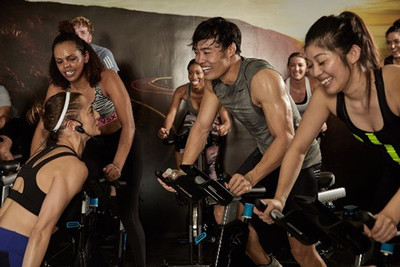
Staying Fit for Summer: Indoor Cross Training
Posted by Spinning® on Jul 3rd 2018
This summer, don’t let thundershowers or high temperatures thwart your training program. Keep your training indoors with these class ideas and cross training options!
Spinning® offers one of the best low-impact and safest exercise programs on the planet. But there are a multitude of training options and benefits that are an appealing and a safe alternative to exercising in excessive heat. In fact, indoor workouts may actually help you to reach your training goals faster with a mix of cross training that keeps workouts interesting, safe and—most importantly—fun!
Heat and Exercise
Although most periodization schedules take advantage of the long days and comfortable weather afforded by the summer season, training in excessive heat and humidity can be extremely taxing on the body. Studies on endurance training have proven that one of the biggest factors contributing to fatigue during exercise is heat, which is not only detrimental to performance, but can also lead to serious heat-related illnesses like cramps, heat syncope and heat stroke1.
Remember that our bodies produce sweat to release heat through our skin (via evaporation) and lower the body core temperature. However, hot and humid weather can inhibit this vital function and lead to serious health issues. By training in comfortable, low-humidity temperatures, you will be better able to maintain your body’s energy stores and thermoregulatory system to function at its best.
Benefits of Indoor Cross Training
If you have not already mapped out a periodization schedule, why not use this month to gradually incorporate indoor cross training into your exercise program? By adding a new sport or training method to your schedule, you will add variety to your workouts, balance the natural work and rest cycles of the body and help prevent overuse injuries, burnout and performance plateaus.
We’ve already explored the virtues of creating fusion classes with Spinning®. After all, Spinning® is a low-impact activity on best-in-class Spinner® bikes with adjustments for every rider. Because Spinning® provides both high intensity workouts and active recovery without excess stress to the joints, students can experience a personalized ride in every class. And by focusing on specific training objectives during each class, you can help your students map out a training plan to boost performance and maximize results.
Along with all of these benefits, there is also research supporting the benefits of cross training using two or more disciplines to strengthen the entire body. Although the concept of specificity will enable students to master a distinct modality, cross training offers an opportunity to explore new ground and keep your fitness program feeling fresh. According to one study, cross training actually improved students’ performance in running.2
Cross Training Options
Running, swimming and weight training are some of the best choices for cross training, and they can all be done indoors. All of these activities focus on different muscle groups and vary in intensity. And when they’re combined, they help lend much-needed balance to any training program.
- Running
Let’s look at the bright side of that 2x5' revolving belt. Convenient, consistent and accessible anytime, treadmills are a great tool to track progress and apply training techniques objectively. Because they are indoors, treadmills eliminate environmental factors like humidity and distractions like traffic, you can devote complete attention on your workout ahead. Treadmills are also designed to be gentler on the joints than road surfaces, reducing both the impact forces and the risk of injury. And just like being on a Spinner® bike, you can call on your visualization cues to bolster the mind/body connection. If you are passionate rider looking for another calorie-burning exercise with minimal gear, think about giving your nearby treadmill a chance. - Swimming
Non-impact and generally low-intensity, swimming builds strength while lengthening muscles throughout the body to improve overall conditioning. By requiring the body to work in all planes of movement (including the frontal, transverse and saggital planes) swimming demands core strength. It can also be therapeutic; the water’s buoyancy supports the muscles to reduce inflammation or recover from injury. - Strength & Core Training
Group exercise schedules are packed with Pilates, yoga, functional training and core classes, offering various movements and intensities that improve whole body conditioning, strengthen muscles and develop flexibility. Equally important, they can help reduce stress and relax both the body and mind. There are even fusion classes that combine the cardio benefits of Spinning® with core training programs like yoga. You can try the Spin® Yoga or Spinning® and Core Training workshops for complete fusion workouts that are both safe and effective.
Putting It All Together
While we can certainly take advantage of the sunshine this summer, we want to ensure that indoor training remains part of our routine. And cross training will keep up the excitement and make it feel fresh. You can develop an indoor triathlon or duathlon training program (perfect for anyone training for a big outdoor event!), or simply offer incentives to your students who complete a combination of classes for cross training benefits.
Once you find something fun that facilitates your overall training goals, you will be on your way to mastering new horizons and making indoor cross training part of an inspiring fitness journey.
Think you know about cross training with Spinning®? Prove it! Take the quiz and earn one CEC toward your recertification.
Take the CEC Quiz
This article was contributed by Lisa Hamlin – Director of International Education Programs, Mad Dogg Athletics Inc.
References
(1) Mayo Clinic Staff (2017). “Heat and exercise: Keeping cool in hot weather.” Mayo Clinic. Found at: https://www.mayoclinic.org/healthy-lifestyle/fitness/in-depth/exercise/art-20048167
(2) Foster, C., Hector, L. L., Welsh, R., Schrager, M. Green, M. A., Snyder, A. C. “Effects of specific versus cross-training on running performance.” European journal of applied physiology and occupational physiology. Found at: https://www.ncbi.nlm.nih.gov/pubmed/7649149
